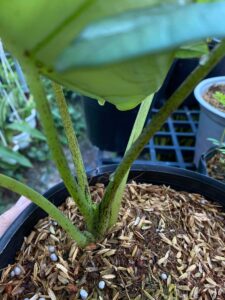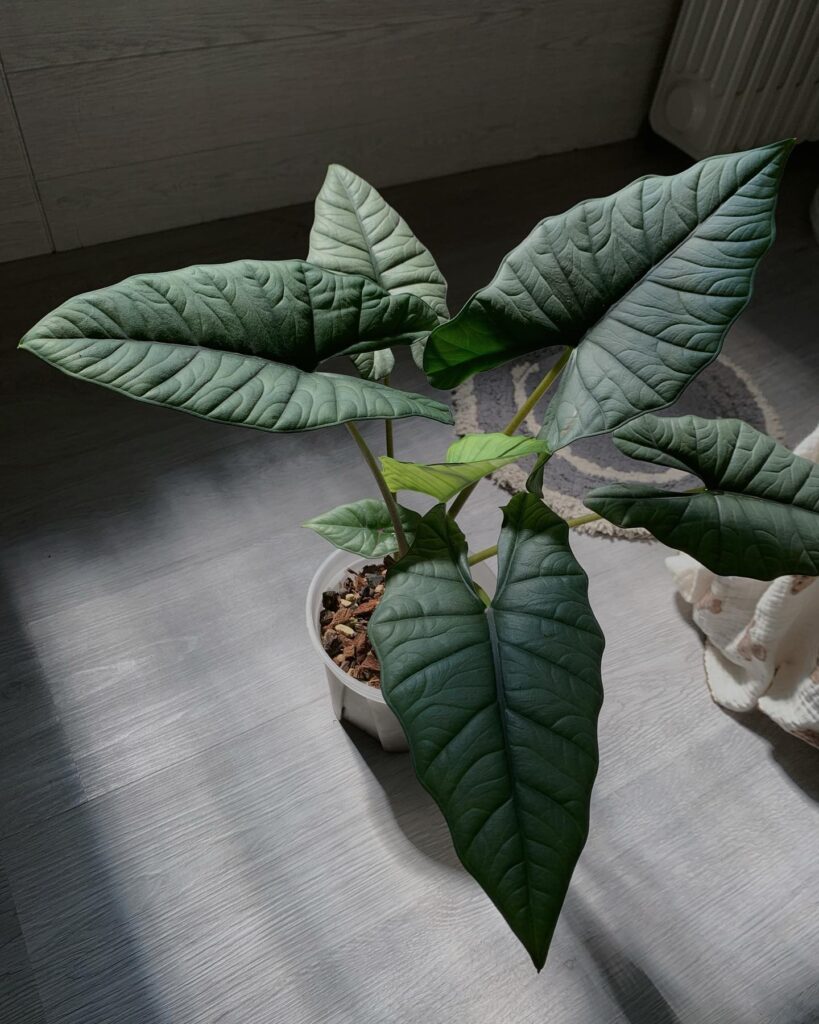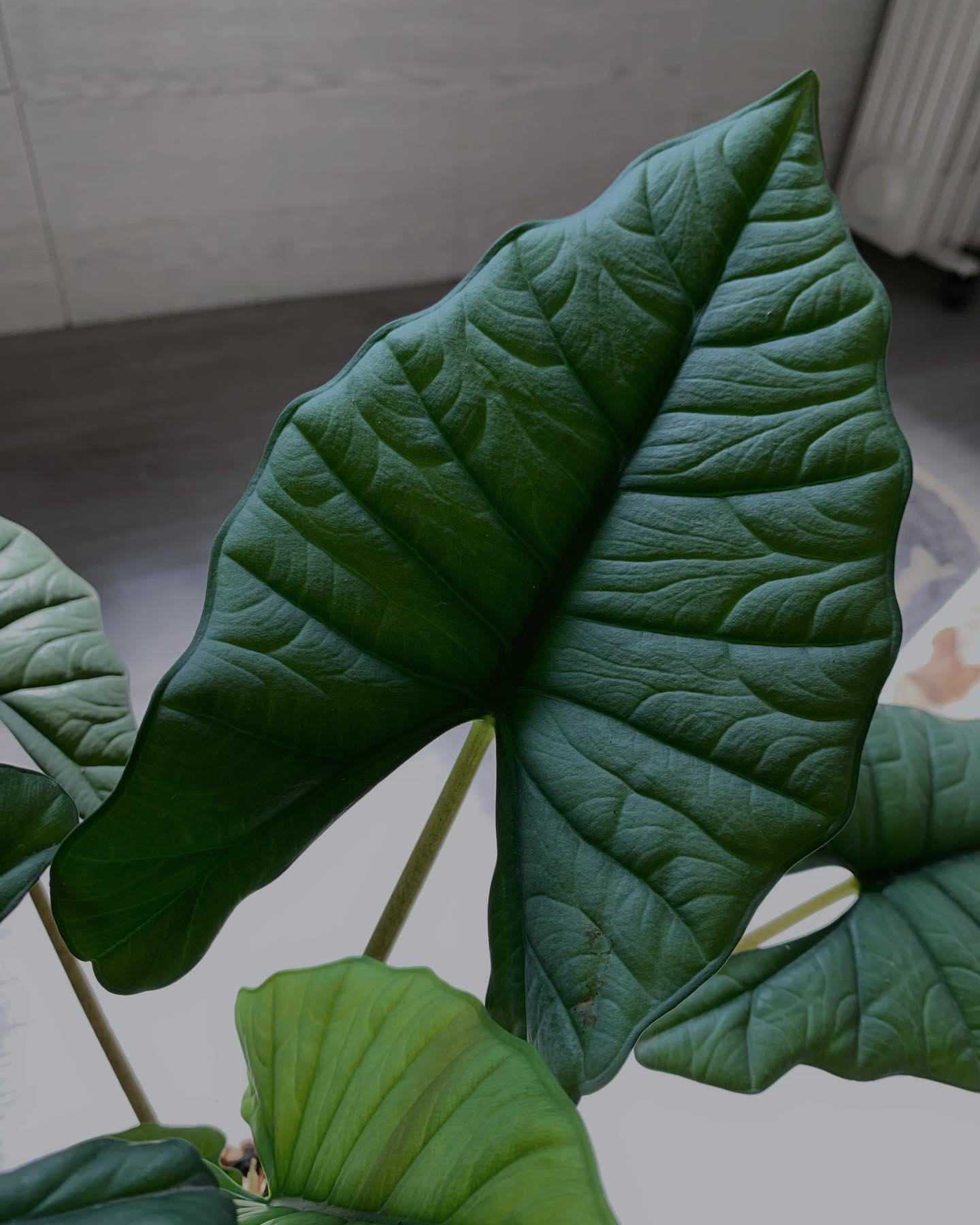Basic Information
Alocasia Melo is a stunning houseplant with unique foliage resembling a walnut’s skin. It’s perfect for plant enthusiasts looking for something out of the ordinary. To grow it successfully, replicate its native environment.



Light
Alocasia Bisma flourishes in medium to bright indirect sunlight. Direct sunlight can scorch its leaves, while too little light may impede growth. Position it 2-3 feet from a window for optimal growth, ensuring a mix of light and shade. This mirrors its natural habitat on the forest floor, where it receives filtered sunlight.
Water
This plant enjoys consistent moisture, with watering every 2 weeks being ideal. Allow the top 2-3 inches of soil to dry out between waterings to prevent root rot. Alocasia Bisma is sensitive to both over and under-watering, so maintaining a balance is key. Misting can also help maintain adequate moisture.
Soil
Alocasia Bisma thrives in loose, nutrient-rich potting soil, ensuring good drainage while retaining adequate moisture. A mix containing organic matter like coco coir, peat moss, or shredded leaves is ideal. Avoid soils with moisture-retaining crystals and opt for ones that allow for air and water flow.
Temperature
Alocasia Bisma prefers a warm environment, thriving in temperatures between 18-25ºC (64-77ºF). Protect it from sudden temperature changes and cold drafts, which can stress the plant and affect growth. Remember, it’s a subtropical plant and favors conditions similar to its natural habitat.
Humidity
Alocasia Bisma thrives in high humidity due to its subtropical origins. To maintain its health and promote growth, it is recommended to mist the plant regularly, use a pebble tray, or place it near other plants. These methods help to recreate the humid conditions of its natural ecosystem, which are essential to the well-being of the plant.
Fertilizer
During spring and summer when Alocasia Bisma is actively growing, it is recommended to feed it every two weeks with a balanced liquid fertilizer that has been diluted to half strength. However, during fall and winter, fertilizing should be reduced to once a month. Over-fertilizing should be avoided as it can cause leaf burn. It is important to be cautious and adjust the frequency accordingly.
Growth Rate
Alocasia Melo is a small plant that grows at a moderate pace, reaching a height of approximately 20-25 inches. If given proper care and optimal growing conditions, it will steadily increase in size over time. However, if it is not grown in the right conditions, it may slow down or even become dormant.
Pet Safety
Alocasia Bisma is toxic to pets. If ingested, it can cause irritation and discomfort. Ensure it’s placed out of reach of curious pets and children, and take immediate action if accidental ingestion occurs.
Grow in Semi-Hydro
- Alocasia plants excel in Semi-hydroponics (LECA/Pon) due to their natural inclination for root growth and humidity.
- Successfully transitioning Alocasia to Semi-hydroponics is enhanced with a Nutrient Stagnant Wicking (NSW) setup.
- Alocasia roots adapt seamlessly to the water in LECA/Pon, with quick resolution of any root hair issues in NSW setups.
- Fertilizer includes a nutrient mix concentration of approximately 800-1000ppm.
- These plants are versatile in different temperature and humidity settings, thriving in controlled environments.
- Long-term care involves maintaining a constant water reservoir and performing occasional system flushes for sustained growth.
Tips
- Rotate the plant regularly for even light exposure.
- Avoid overwatering; only water when the soil’s top layer is dry.
- Use well-draining soil to prevent root rot.
- Maintain high humidity around the plant.
- Protect from direct sunlight to prevent leaf burn.
- Use a balanced fertilizer, diluted to half strength.
- Monitor for pests like mealybugs or aphids.
- Prune any yellow or damaged leaves to encourage new growth.
- In winter, reduce watering and stop fertilizing.
- Repot only when the plant becomes root-bound.
Caring for Alocasia Bisma is a delightful experience that adds a slice of the subtropics to your indoor garden. Nurture this unique addition to your plant collection!
Happy planting! 🌱


